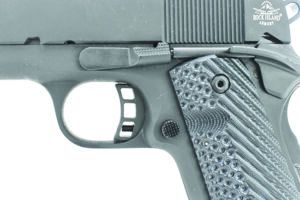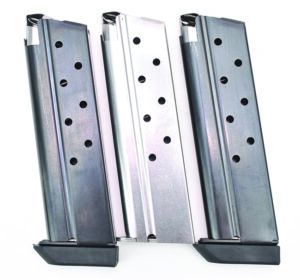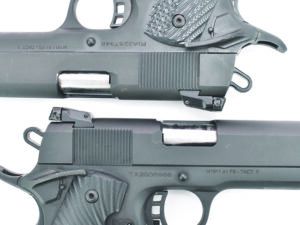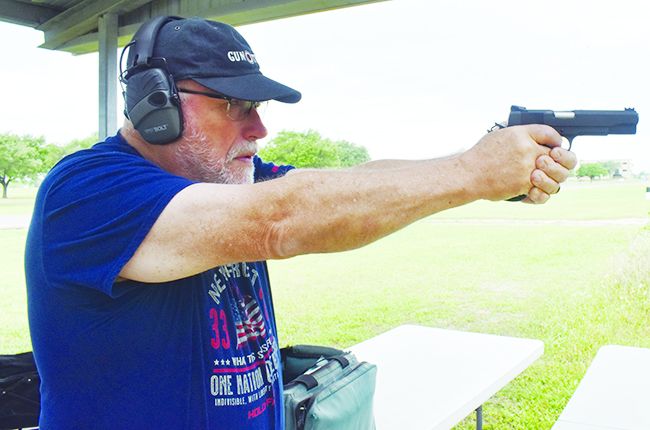Once considered an almost extinct cartridge, the 10mm Auto has rebounded to reach beyond cult status today. It appears that many Gun Tests readers like this high-energy 40-caliber round because we keep getting requests to test additional pistols chambered for the 10mm cartridge. So, this time, we add three 1911-style handguns.
The first is from Rock Island Armory, the M1911 FS Tactical II, $700. Made by Armscor, this all-steel flat-black bull-barrel pistol has the weight to mitigate some of the recoil generated by a good 10mm round. Beginning corporate life as Squires, Bingham and Co., the trading entity that morphed into Armscor can trace its roots back to the Philippines near the turn of the twentieth century. Now the world’s largest producer of 1911-style firearms, Armscor knows a thing or two about making this platform run — and producing a good product at an affordable price under the Rock Island Armory brand. The FS Tactical II is a great example of their work.
The second is the Dan Wesson Razorback, a stainless-steel version with some gorgeous rosewood grips, $1622. Our Dan Wesson begins with a stainless-steel slide and a forged stainless frame. The flats have been well polished and are unbroken except for the seven diagonal cocking grooves at the rear. The top of the slide has an inverted rib milled into it that leaves flat, longitudinal serrations running almost the length of the slide. The combination of the rib and a bead-blasted upper surface leaves a very glare-resistant finish.
We also got a newly announced 10mm pistol that looks a whole lot like the Armscor and is also priced at $700. When we opened the package containing the Taylor’s & Company M1911A1 FS Tactical II, we were impressed with the solid-looking pistol that emerged. We saw a fiber-optic front sight to go with the adjustable rear. Ambi safety, lightweight trigger, lowered and flared ejection port, checkered mainspring housing, bull barrel, nice grips — it was all there.
We shot this trio at American Shooting Centers in Houston, firing the pistols for accuracy at 15 yards. We tested using three different types of ammunition. The first was a 165-grain JHP (jacketed hollow point) from Cor-Bon. Second was a 180-grain FMJ (full metal jacket) from Armscor, also the parent company for the Rock Island Armory pistol in this test. Last was some 180-grain V-Crown fodder from SIG Sauer. Here’s how the handguns fared:
Gun Tests Grade: B+ (BEST BUY)
$700
The timeless characteristics folks love about the 1911 are here. There’s a slab-sided barrel and thin grip frame to go along with a straight-pull trigger. Then there are added features that have become so popular, with the first readily apparent upgrade being the sights.
| Action Type | Semi auto, hammer fired |
| Overall Length | 8.75 in. |
| Overall Height | 5.7 in. including magwell |
| Maximum Width | 1.42 in. |
| Weight Unloaded | 2.55 lbs. |
| Weight Loaded | 3.06 lbs. |
| Slide | Matte-blue carbon steel |
| Slide Retraction Effort | 24.3 lbs. |
| Receiver | Matte-blue carbon steel |
| Receiver Front Strap Height | 2.75 in. |
| Receiver Back Strap Height | 3.5 in. |
| Receiver Barrel Length | 5.0 in. |
| Receiver Grip Thickness (Maximum) | 1.289 in. |
| Receiver Grip Circumference | 5.4 in. |
| Magazines | Two 8-round blued, w/basepad |
| Rear Sight | Two-dot LPA adjustable |
| Front Sight | Red-fiber-optic in dovetail |
| Sight Radius | 6.5 in. |
| Trigger Pull Weight | 3.5 lbs. |
| Trigger Span | 2.9 in. |
| Safeties | Grip and thumb |
| Warranty | Limited |
| Telephone | (775) 537-1444 |
| Website | RockIslandArmory.com |
| Made In | Philippines |

Only 20 years ago, we were still seeing thin-bladed rear sights and wafer-thin front sights. They were difficult for the eye to pick up and tended to wash out in less-than-optimum lighting conditions. Our FS Tactical II solves that problem handily. The front sight is a red fiber optic with lots of pipe open on the top to gather a ton of light. Some people prefer green pipes because the human eye sees that frequency better. We suggest that you also consider the backdrop against which the sight is most likely to be used. This test group is in southeast Texas, which is very green. The red insert is much more visible here. The rear sight is made by LPA. Looking somewhat like an adjustable Novak-style sight, the blade is adjustable for both windage and elevation. It also sports the two white dots. Together, the two parts were easy to see and easy to correct.
The slide seems to be a standard Series 70 configuration. No firing-pin safety on this unit to gum up the trigger pull. We counted 19 cocking grooves located in the rear of slide. The walls of the ejection port have been properly lowered, and the rear has been nicely tear-dropped. Barrel lockup was very tight, with no felt movement when we pushed down on the hood or shook the RIA from side to side. It has a definite nose-heavy feel due, primarily, to the 5.0-inch bull barrel. We measured the muzzle at 0.700 inch in diameter versus 0.58 inch on the conventional-barrel Dan Wesson. When all the speed-shooting results were tabulated, that extra weight contributed to a 0.035-second advantage for the RIA and the Taylor’s versus the Dan Wesson – not much, but noticeable.

The all-steel frame contributes more weight. Remember that a full-house 10mm cartridge will deliver double the energy a good 9mm can provide. All that energy comes with a cost in the form of recoil and muzzle flip. Are they too much? No, but it is a good thing to know about so you can practice before you need it. The 24-pound recoil spring helps, but that makes these pistols more of a challenge to cycle by hand. If that proves to be a bit difficult, try cocking the hammer manually first and then rack the slide. The hammer is usually operated by an 18-pound spring. Try operating them separately if racking is too difficult.
And that’s not all for the frame. RIA provided a good ambidextrous thumb safety, a beavertail grip safety that sports a bit of a memory bump, a slotted hammer, and a lightly beveled magazine well. Attached to the metal checkered mainspring housing is an additional mag funnel that adds length to the grip frame and makes a huge funnel for those trying to change magazines in a hurry. Two blued eight-round magazines are provided and include a screwed-on base pad to make sure the mags have sufficient length to be seated past the magwell. The magazine release is standard (non-reversible) and is designed to be activated by the right thumb. For the southpaws, no problem. Use the tip of your left index finger. That is SOP for us when we shoot support hand, and it works just fine.

Somewhat to our surprise, the trigger was made of ferrous metal, which weighs more than the anticipated alloy version. It also had an overtravel stop. Take up was short, as expected, and only required about 3.5 pounds of pressure to activate.
Last of the features are the G10 grip panels held on by two Torx-head screws. The rear of those panels is grooved diagonally, while the forward portion is dimpled. Edges were a bit sharp, and we were glad we brought along gloves when we did the extended shooting of this pistol. Careful application of some 600-grit sandpaper could be to many folks’ liking.
Our Team Said: Function was flawless over some 175 rounds. Accuracy was the best recorded of the three pistols in this test. This Rock Island averaged a mere 1.47 inches across five-shot groups fired at 15 yards with three different types of ammo. Its favorite, by a small margin, was the 180-grain FMJ made by Armscor, RIA’s parent company. We would like to see the memory bump at the bottom of the grip safety to be a bit higher for those with less-than-beefy hands and the grip panels to be a bit less abrasive.
10mm Auto Range Data
Our shooters fired these pistols at American Shooting Centers in Houston. We shot them for accuracy at 15 yards by firing multiple five-shot groups from a sandbagged Caldwell Pistol Rest and a Mini DRC Fortune Cookie from Wiebad.com. We used a LabRadar chronograph to measure velocities.
| Cor-Bon 165-grain JHP | Taylor’s FS-Tactical | Rock Island FS-Tactical | Dan Wesson Razorback |
| Average Velocity | 1232 fps | 1280 fps | 1252 fps |
| Muzzle Energy | 556 ft.-lbs. | 600 ft.-lbs. | 575 ft.-lbs. |
| Average Group | 8.75 in. | 1.55 in. | 2.70 in. |
| Best Group | 5.63 in. | 1.21 in. | 2.51 in. |
| Armscor 180-grain FMJ | Taylor’s FS-Tactical | Rock Island FS-Tactical | Dan Wesson Razorback |
| Average Velocity | 1065 fps | 1111 fps | 1090 fps |
| Muzzle Energy | 453 ft.-lbs. | 493 ft.-lbs. | 475 ft.-lbs. |
| Average Group | 1.77 in. | 1.36 in. | 1.47 in. |
| Best Group | 1.75 in. | 1.30 in. | 1.34 in. |
| SIG Sauer 180-grain V-Crown | Taylor’s FS-Tactical | Rock Island FS-Tactical | Dan Wesson Razorback |
| Average Velocity | 1219 fps | 1255 fps | 1226 fps |
| Muzzle Energy | 594 ft.-lbs. | 629 ft.-lbs. | 601 ft.-lbs. |
| Average Group | 1.72 in. | 1.52 in. | 1.44 in. |
| Best Group | 1.34 in. | 1.24 in. | 1.19 in. |
Drill Data (5x5x5)
Process: Fire five shots from draw at a 5-inch circle placed at 5 yards. Numbers are averages for two repetitions.| Pistol | Time to First Shot (seconds) | Split Average (seconds) | Total Time (seconds) |
|---|---|---|---|
| Taylor’s & Co. | 1.49 | 0.303 | 2.700 |
| Dan Wesson | 1.54 | 0.379 | 3.065 |
| Rock Island Armory | 1.545 | 0.306 | 2.770 |
DRILL DATA (5x8xA ZONE)
Process: Fire five shots from draw at A zone (5-by-11 inches) at 8 yards. Numbers are averages for two repetitions.| Pistol | Time to First Shot (seconds) | Split Average (seconds) | Total Time (seconds) |
|---|---|---|---|
| Taylor’s & Co. | 1.545 | 0.253 | 2.555 |
| Dan Wesson | 1.495 | 0.244 | 2.470 |
| Rock Island Armory | 1.465 | 0.243 | 2.435 |




























I purchased a Rock Island 1911 FS in 10 mm. The guns shoots great but I think Gun Tests received special consideration. You received two magazines. I received one. When I both inquired at Armscor and Guns.com, I was told there was no mistake but that the pistol is furnished with only one magazine. I’ve been shooting a long time and have several 1911s and other semi-auto pilots. Till now, each and every one of them came with two magazines, if not three. Either someone somewhere helped themselves to a freebee or the gun comes with only one magazine. Magazines from Rock Island, Chip McCormack or Metal Form (recommended by RIA) range from $35 to $40. So if someone is planning an RIA 1911 purchase, be aware that you’ll be spending more on one or two more magazines, probably two.